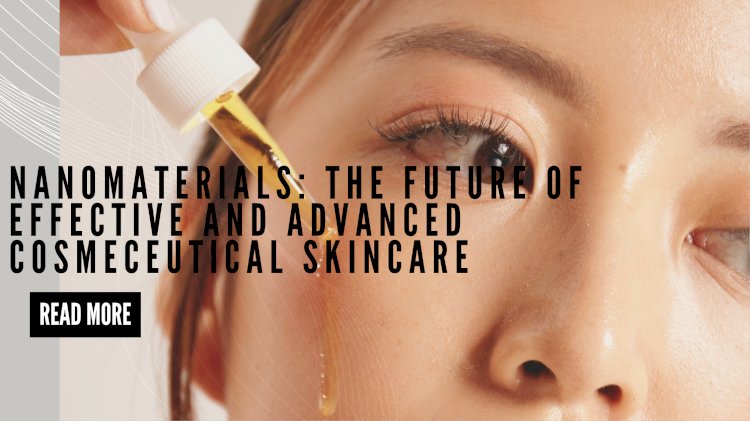NANOMATERIALS: THE FUTURE OF EFFECTIVE AND ADVANCED COSMECEUTICAL SKINCARE
In this blog, we explore the exciting intersection of nanotechnology and cosmeceutical product development. As the skincare and beauty industry evolves, nanomaterials are transforming how we approach skincare, offering products that are not only more effective but also safer and longer-lasting. From enhanced absorption and controlled delivery to improved stability and anti-aging benefits, discover how nanomaterials are shaping the future of skincare. We also discuss the challenges facing this new frontier, including safety concerns, regulation, and consumer awareness. With continued innovation, nanotechnology promises to revolutionize cosmeceuticals and provide a new generation of skincare solutions for healthier, more youthful skin.

NANOMATERIALS: THE FUTURE OF EFFECTIVE AND ADVANCED COSMECEUTICAL SKINCARE
In the rapidly evolving world of skincare and beauty, the term cosmeceutical has garnered significant attention. This hybrid of "cosmetic" and "pharmaceutical" represents products that not only improve the appearance of the skin but also offer therapeutic benefits. What is now taking the world by storm, however, is the incorporation of nanotechnology into cosmeceutical product development. The use of nanomaterials in cosmetics is creating a new frontier of innovation, making products more effective, safer, and longer-lasting.
In this blog, we’ll explore how nanomaterials are transforming the cosmeceutical industry, their benefits, challenges, and the future of skincare powered by these microscopic wonders.
What Are Cosmeceuticals?
Cosmeceuticals are skincare and beauty products that contain bioactive ingredients intended to improve the skin’s health and appearance at a deeper, cellular level. Unlike traditional cosmetics that simply enhance appearance, cosmeceuticals are formulated to have a therapeutic effect—such as reducing wrinkles, treating acne, or combating hyperpigmentation.
Some common examples of cosmeceuticals include anti-aging creams, sunscreens with advanced UV filters, skin-lightening products, and acne treatments. The key difference between a regular cosmetic and a cosmeceutical is that the latter typically contains active ingredients that have been clinically proven to yield noticeable results over time.
What Are Nanomaterials?
Nanomaterials are materials that have been engineered at the nanoscale, typically ranging from 1 to 100 nanometres. At this size, materials exhibit unique properties, including increased surface area, reactivity, and sometimes different mechanical, optical, or electrical characteristics compared to their larger counterparts.
In the context of skincare, nanomaterials can be used in a variety of forms, including:
- Nanoparticles: Tiny particles used to deliver active ingredients more effectively to the skin.
- Nanostructures: Specialized shapes or structures that enhance stability or release rates.
- Nanocapsules: Encapsulated delivery systems that ensure the slow release of active ingredients, providing prolonged effects.
The Role of Nanomaterials in Cosmeceutical Product Development
1. Enhanced Absorption and Penetration
One of the most notable benefits of nanomaterials in cosmeceuticals is their ability to enhance the absorption and penetration of active ingredients. Traditionally, large molecules in skincare products could only penetrate the upper layers of the skin. However, nanoparticles are small enough to pass through the skin's natural barrier and reach deeper layers where they can exert their therapeutic effects.
For example, nanocapsules containing Vitamin C or retinol can deliver these powerful antioxidants deeper into the skin, increasing their efficacy and reducing their degradation. This results in better, longer-lasting effects and faster results from products like anti-aging creams or brightening serums.
2. Controlled and Targeted Delivery
Nanomaterials allow for a more controlled and targeted delivery of active ingredients. This is especially important when it comes to sensitive actives like peptides, proteins, and antioxidants that can be unstable in larger quantities or in their natural form.
By encapsulating these ingredients in nanocapsules, they are protected from environmental factors like oxidation or UV degradation until they reach their target area in the skin. This ensures that the active ingredient is released precisely where and when it’s needed, maximizing its effectiveness.
Moreover, controlled delivery systems can also reduce the risk of irritation caused by potent ingredients. By using nanomaterials, the active ingredients can be released gradually over time, minimizing side effects and providing a sustained therapeutic effect.
3. Improved Stability and Efficacy
Nanotechnology enhances the stability of ingredients that are otherwise prone to breakdown due to factors like light, heat, or air exposure. For example, Vitamin C is notoriously unstable and can degrade quickly when exposed to air and light, reducing its effectiveness in skincare products.
However, when encapsulated in nanoparticles, the Vitamin C is protected and remains stable for longer periods, even after being applied to the skin. This ensures that the product provides long-term benefits, and the active ingredients maintain their potency.
4. Anti-Aging and Skin Regeneration
Nanotechnology is also revolutionizing anti-aging products. Nanomaterials, such as liposomes and nanospheres, are now commonly used to deliver active ingredients like growth factors, peptides, and stem cells deep into the dermal layers of the skin. These ingredients can stimulate collagen production, promote skin regeneration, and reduce the appearance of wrinkles and fine lines.
Because the nanomaterials can deliver these ingredients to the deepest layers of the skin where collagen and elastin are produced, the benefits are more pronounced and long-lasting compared to conventional anti-aging products.
5. Sunscreen Protection
Another major advancement brought about by nanomaterials is in the realm of sunscreens. Traditional sunscreens used to rely on physical filters like zinc oxide or titanium dioxide, which often left a white, chalky residue on the skin. However, these minerals in their nanoscale form are more transparent, providing effective sun protection without the unsightly residue.
Furthermore, the smaller particles allow for better dispersion on the skin, leading to more even protection. Nanoparticles of titanium dioxide and zinc oxide can also provide more efficient UV absorption, reducing the risk of UV-induced skin damage, sunburn, and premature aging.
Challenges of Using Nanomaterials in Cosmeceuticals
While the benefits are significant, the incorporation of nanomaterials into skincare products isn’t without its challenges.
- Safety Concerns: There are ongoing debates regarding the safety of nanoparticles. Given their small size, there’s concern about whether they could penetrate the skin barrier too deeply, potentially causing irritation or systemic exposure. Extensive research and regulation are necessary to ensure that nanomaterials used in cosmetics are safe for both short- and long-term use.
- Regulation and Standards: The regulatory landscape for nanomaterials is still evolving. In many countries, there are no clear guidelines specifically for nanomaterials in cosmetics. As a result, manufacturers must ensure that they meet current safety standards while awaiting more comprehensive guidelines.
- Cost and Complexity: Developing nanomaterial-based cosmeceuticals is often more expensive than traditional formulations. The technology required to produce and stabilize nanomaterials is complex and may increase the cost of production, which could affect the price of the final product.
- Consumer Awareness: Many consumers may not be fully aware of the potential benefits of nanomaterials in skincare. Proper education and communication from brands are crucial to ensure consumers understand the value of these products.
The Future of Cosmeceuticals with Nanotechnology
The future of cosmeceutical products lies in the continued advancement of nanotechnology. As research continues, new and innovative applications for nanomaterials will emerge, enabling more effective treatments for skin conditions like acne, hyperpigmentation, eczema, and even more personalized skincare solutions.
Additionally, as safety guidelines and regulations improve, the industry will likely see more widespread adoption of nanomaterials in skincare products. The result will be a new generation of products that offer superior performance, more targeted treatments, and long-lasting results, leading to healthier, more youthful skin.
In the coming years, we can expect to see more cosmeceutical innovations powered by nanotechnology, providing consumers with products that go beyond cosmetic enhancements to truly transform skin health from within.
IBRI Noida: Leading the Way in Cosmeceutical Product Development with Nanomaterials
The Indian Biological Sciences and Research Institute Research (IBRI) in Noida is at the forefront of educating professionals and students on cutting-edge topics in biotechnology and bioengineering. Among its specialized offerings is a comprehensive course on Cosmeceutical Product Development using Nanomaterials. This course provides participants with in-depth knowledge of the latest advancements in nanotechnology and its application in the cosmeceutical industry. Students and professionals gain practical skills in formulating, developing, and testing skincare products that utilize nanomaterials for enhanced efficacy and stability. Led by industry experts, the course covers everything from the science of nanomaterials to regulatory challenges and safety protocols, ensuring that participants are equipped with both the technical expertise and real-world insights to excel in this rapidly growing field. For those looking to break into the evolving world of cosmeceuticals or refine their existing skills, the IBRI Noida course offers a unique opportunity to stay ahead of the curve and lead innovations in skincare science.
Conclusion
Nanomaterials are revolutionizing the development of cosmeceutical products, bringing enhanced absorption, targeted delivery, and improved stability to skincare formulations. As this technology advances, it holds the promise of providing more effective, long-lasting, and safer skincare solutions. However, as with any new technology, challenges like safety concerns and regulatory hurdles must be addressed to ensure that the benefits of nanomaterials can be fully realized in the cosmeceutical industry. With continued research and innovation, the future of skincare powered by nanotechnology looks brighter than ever.































